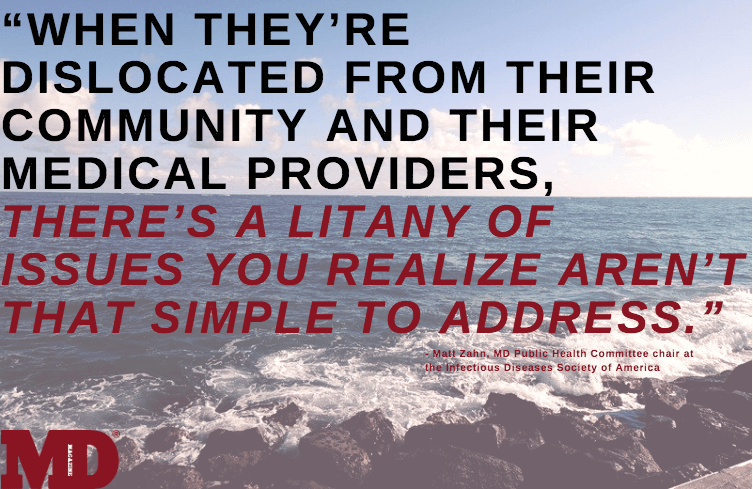Article
Infections, Illnesses Loom in Puerto Rico Aftermath
Author(s):
Weeks after Hurricanes Maria and Irma, the US territory races bacteria to restoring public health infrastructure.

Risks can come in stages during a weather emergency.
There’s first the natural event — a flood, hurricane, tornado, tsunami, earthquake. Then there’s the aftermath, as responders rush to locate at-risk survivors, give aid to victims, and provide shelters for the relocated.
Another stage can come. If the affected area’s infrastructure is not restored in due time, disease can spread quickly. Donated food and water is infected with bacteria, the lack of proper plumbing causes mass contamination, and overcrowded shelters become a hub for illnesses.
Matt Zahn, MD, has seen this stage firsthand. The current Public Health Committee chair at the Infectious Diseases Society of America (IDSA) once worked for a medical department in Louisville, KY. He recalled to MD Magazine a major flooding that once relocated thousands of Louisiana residents to his region, and taught him how important public health systems are in the wake of disaster response.
“When they’re dislocated from their community and their medical providers, there’s a litany of issues you realize aren’t that simple to address,” Zahn said.
Such issues are rising in Puerto Rico. The island home of 3.4 million is still reeling from the damage caused by Category 5 Hurricane Maria, the worst recorded natural disaster in the Commonwealth of Dominica — which touched down 3 weeks ago. It was preceded by Hurricane Irma, less than 2 weeks prior.
As of this week, over 100 people were still unaccounted for, according to the US territory’s Department of Public Safety, and the death toll had reached 45. The public health system has been seemingly destroyed by the flooding and 100 mph winds, as there are reports that less than half of the island’s medical employees have reported in the weeks following the storm. Dialysis patients have had treatment hours reduced by 25% due to a lack of diesel supply needed to run generators.
Energy issues aren’t expected to be resolved soon. About 90% of the island is without power, according to a report this week. The government is hopeful it will have electricity completely restored by March — 5 months from now. Utility workers and the Army Corps of Engineers worked to install generators for medical facilities and restore power to 36 hospitals this week.
There’s also expressed concern for damages to Puerto Rico’s manufacturing service. In a statement earlier this week, US Food and Drug Administration commissioner Scott Gottlieb noted the significance of pharmaceutical product possibly affected on the island.
“According to data from the Bureau of Economic Analysis, the pharmaceutical products manufactured in Puerto Rico make up nearly 10 percent of all drugs consumed by Americans,” Gottlieb said. “And that doesn’t even account for medical devices. Puerto Rico is vital to the health and wellbeing of all Americans.”
Responders are racing against a clock now. Chronic disease patients in need of frequent and advanced therapy — such as those diagnosed with Hepatitis C, HIV, or tuberculosis — are in need of a stable public health system, Zahn said.
He also noted leptospirosis, a bacterial condition spread through infected animal urine which has now been diagnosed in 10 Puerto Rico patients, and is responsible for 4 deaths.
The disease is commonly associated with flooding events in warm climates, Zahn said, and people without access to safe drinking water are at great risk.
“It appears as flu-like, initially, but it can become serious and lead to kidney or liver failure,” Zahn said. “The immediate concern is unusual infections like that.”
There’s also concern for gastrointestinal infections being spread via unsecure food and water, Zahn said, as well as vector-borne illnesses such as Zika virus. The longer health infrastructure remains disrupted, the more public health issues will arise.
"People are concerned with mosquito-borne illnesses,” Zahn said. “If time goes on and public health systems cannot conduct proper mosquito abatement, there’s reason for concern.”
In a letter dated October 11, IDSA president Paul Auwaerter, MD, FIDSA, expressed support for an immediate federal infusion of emergency funding for essential medicines and healthcare supplies. Auwaerter noted that health workers in affected areas are “bracing for potential infectious disease outbreaks.”
“Ensuring that basic needs are met including access to clean water, safe food and sanitation as essential for infection control,” Auwaerter wrote.
Zahn agreed with the notion that residents outside of affected sites may misinterpret the priority of donated supplies — that they may not realize bottles of water, packaged food, and other essential materials are necessary to avoid health disasters. Like the stages of risks following disaster, getting these supplies is one of the stages to recovery.
Unfortunately, it’s a very early stage.
“Whenever you have shelters set up, you want to make sure people have adequate access to safe food and water supplies, and adequate access to bathrooms,” Zahn said. “Trying to restore those becomes Job One, then you move on to restoring that infrastructure.”





